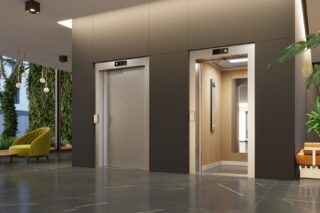The Hainan Science Museum, designed by MAD Architects and set to open in 2025, combines sustainable innovation with cultural preservation, reflecting Hainan’s commitment to science, education, and harmonious development with its natural and traditional environment.
Hainan, China—The construction of the Hainan Science Museum has reached a major milestone with the completion of its main structure in June 2023, marking significant progress in this ambitious project. Located in Haikou’s Jiangdong New District, the museum is poised to become a central hub for science and technology education in the region. The facility spans 46,900 square meters and will feature seven dedicated exhibit areas, showcasing a diverse range of scientific disciplines from marine ecosystems to aerospace technology. The museum’s design emphasizes harmony with the natural environment, reflecting a commitment to sustainability and innovative urban development.
Scheduled for full completion in 2025, the Hainan Science Museum will open its doors to the public as the province’s first large-scale, comprehensive science museum. This project highlights Hainan’s dedication to leveraging science and technology as pillars of economic growth and public engagement. Once completed, the museum is expected to draw thousands of visitors, boosting Hainan’s profile as an emerging international tourism and free trade hub. The museum will serve not only as an educational institution but also as a symbol of Hainan’s forward-looking aspirations in the global scientific community.


A Thoughtful Design: Balancing Efficiency, Experience, and Nature
The Hainan Science Museum’s architecture is a testament to resource efficiency and sustainability. The design by Ma Yansong/MAD Architects meticulously integrates the building’s core, floor plates, and curved façade, optimizing space and materials to minimize waste. The structure itself becomes part of the museum’s narrative, with circulation and functional layouts seamlessly woven into the architectural framework. The six-story museum includes five above-ground floors totaling 28,000 square meters and one underground level. A key design element is the spiraling ramp that ascends like a twisting DNA strand, connecting the ground floor to the sixth, bathed in natural light filtering through a glass dome. This thoughtful design not only reduces the environmental impact but also enhances the visitor experience by creating a harmonious flow between spaces.
MAD’s design approach reflects a deep understanding of the diverse needs of its visitors, catering to both children and adults. Younger children, who can easily become overwhelmed in large museums, are provided with dedicated spaces on the second and third floors, where they can engage in indoor learning activities before exploring the adjacent garden. Older children and adults begin their journey at the top, taking an elevator to the sixth floor before descending through the museum via the winding ramp. This route offers curated views of the surrounding garden on one side and the galleries on the other, ensuring an immersive and efficient exploration of the museum’s offerings. The museum is surrounded by sunken plazas and wetlands, which feature a rich array of tropical plants native to Hainan, providing visitors with interactive public spaces that encourage relaxation, learning, and social interaction. As the museum nears its final stages of construction, with the curtain wall and landscape expected to be completed by June this year, it is set to open to the public in 2025, promising to be a landmark of innovation and education.


Integration of Local Construction Materials and Renewal of Traditional Villages
MAD Architects’ project for the Hainan Science Museum in Haikou City, Hainan Province, demonstrates a significant connection between contemporary architectural design and traditional construction materials, as well as a commitment to protecting and respecting local cultural heritage.
Research on traditional villages in the volcanic areas of Hainan highlights the use of locally sourced volcanic rocks, timber, and other natural materials in local construction projects. These materials are prized for their ecological adaptability, with volcanic rock being particularly valued for its durability, lightweight, and resistance to weathering. In traditional Hainanese architecture, volcanic rocks are used extensively for building walls, foundations, and even decorative elements due to their insulating properties and ability to regulate indoor temperatures in tropical climates.
Similarly, MAD’s use of Fiberglass Reinforced Plastic (FRP) panels on the museum’s exterior reflects a modern interpretation of these principles. The panels are designed to accommodate Hainan’s humid, rainy environment with features like open seams and water-guiding grooves, ensuring effective drainage and longevity. This approach mirrors the traditional ecological adaptability of Hainanese construction, where materials and designs were chosen to harmonize with the local climate and environment.
“Resembling an “updraft,” the design mimics the upward movement of warm air from the Earth’s surface. To achieve this flowing and ascending form, the museum’s curtain wall is composed of 843 pieces of Fiberglass Reinforced Plastic (FRP),” the architects explained in a press release.

MAD’s approach to the Hainan Science Museum is also informed by the need to balance modern development with the preservation of traditional cultural landscapes. The research on traditional villages emphasizes the importance of these settlements not only as cultural heritage sites but also as models of sustainable living. These villages have evolved in response to their environment, with structures and layouts that reflect deep ecological knowledge and adaptability.
By situating the museum within a wetland area and integrating it with its natural surroundings, MAD aims to create a building that respects the existing landscape while providing a space that educates visitors on the intersection of technology, science, and nature. The design’s biomorphic form, mimicking natural processes like the updraft of warm air, further underscores this connection to the environment.
Influence on Future Development
The careful study and application of traditional construction techniques and materials in the Hainan Science Museum also serve as a model for future developments in the region. As urbanization continues to transform rural areas, projects like this can help ensure that new buildings are designed with a sensitivity to local cultural and environmental contexts. By blending modern architectural innovation with traditional ecological wisdom, MAD Architects’ project offers a pathway for sustainable development that honors Hainan’s unique cultural heritage.
The Hainan Science Museum project by MAD Architects is deeply connected to the research on local construction materials and the protection of traditional villages. The project reflects an understanding of the importance of ecological adaptability and cultural preservation, demonstrating how modern architecture can engage with and enhance the natural and cultural environment of a region.










